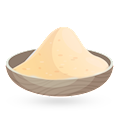MAIN INGREDIENTS
Cantonese mooncakes are a type of traditional Chinese pastry that is notably enjoyed during the Mid-Autumn Festival, which is a significant festival in many Asian countries. These mooncakes are distinctive with their tender, thin, and slightly browned crust and are usually filled with sweet, dense fillings.
The most common filling in Cantonese mooncakes is lotus seed paste, which is smooth and sweet, and usually contains salted egg yolks, representing the full moon and offering a savory contrast to the sweet filling. Another distinctive feature is their appearance: the top of the mooncake is typically embossed with Chinese characters indicating the type of filling, the name of the bakery, and additional decorative motifs.
MAIN INGREDIENTS
Gujiya is a popular North Indian sweet pastry that is traditionally enjoyed during the Holi festival. These crescent-shaped treats are made with thinly rolled dough and a filling consisting of khoya (dried evaporated milk) and chopped nuts such as almonds, cashews, and pistachios.
The dough can be made with all-purpose flour and semolina, while the fillings can sometimes include dry fruit, desiccated coconut, and cardamom. Gujiya can be baked or deep-fried. It is similar and often compared to karanji—a deep-fried Maharashtran pastry usually filled with coconut, poppy seeds, and nuts.
Otap is a sweet, thin, oval-shaped Filipino treat made with puff pastry. These treats are usually small in size, generously sprinkled with sugar, and have an incredibly crispy and crumbly texture. It is believed that otap originated in Cebu, and today it represents a signature product of the entire region.
The sugary biscuits are available at numerous local markets and stores and are usually enjoyed as a light dessert or a sweet afternoon snack.
Awameh is a sweet Syrian dish consisting of small balls of dough which are fried in hot oil and soaked in honey, cinnamon, or sugar syrup. Sometimes, awameh is sprinkled with sesame seeds. The name of the dish means floater in Arabic, referring to the way the balls float on the surface while being fried.
Even though Taichung City offers many signature eats and unique spins on local fare, one of its specialties and most notable standouts is the suncake or tai yang bing. Traditionally prepared since the Qing dynasty era, this delicious Taiwanese flaky pastry filled with gooey, buttery maltose paste is a treat found in every bakery shop in Taichung.
It is even sold as a souvenir, pre-packed in attractive gift boxes. An interesting combination of flavors and textures, the round-shaped Suncakes are most often sweeter than honey and their thick, caramel-like filling perfectly contrasts the dry flakiness of the floury, paper-thin layers of phyllo dough.
An ancient Chinese delicacy eaten during the Mid-Autumn Festival or Moon Festival, known as mooncake, is a pie-like pastry made with a shortcrust base called yueh ping that is traditionally filled with black sesame seed or lotus seed paste, along with red beans, roasted pork, mung beans, dates, and salted duck egg yolks.
Nowadays, mooncakes are available in a variety of different sweet and savory fillings, some of which are fruits like honeydew, litchi or pineapple; chocolate or mixed nuts; abalone and seaweed; green tea, and even cream cheese or ice cream. Their round shape is not only reminiscent of the moon, but also a symbol of return or a full circle, which in Chinese philosophy stands for fulfillment, oneness, perfection, and unity.
VARIATIONS OF Yuebing
MAIN INGREDIENTS
Hanım göbeği is a traditional sweet pastry originating from Turkey. It consists of choux pastry balls that are pressed in the middle to create a dimple, then deep-fried in hot oil and soaked in sugar syrup. The name of this sweet treat means lady's navel, hence the indentation in the middle of the pastry.
The dough is made with a combination of flour, sugar, eggs, butter, and salt, while the syrup is made with a mixture of sugar, water, and lemon juice. The dough should be fried in oil over medium heat, and the pastry is then placed into cold syrup.
MAIN INGREDIENTS
Cream bun belongs to a group of traditional Chinese buns hailing from Hong Kong. Like most other varieties of Chinese sweet buns, this one also consists of a soft and fluffy yeast dough that’s typically made with a combination of bread flour, yeast, eggs, condensed milk, unsalted butter, tangzhong (a mixture of bread flour and water), custard powder, milk powder, salt, and sugar.
This classic bun can be recognized by its elongated elliptical shape; the nice, golden surface resulting from the use of egg wash, and the characteristic split down the middle. After baking, the sweet buns are usually cut open, brushed with sugar glaze, covered with shredded coconut, and filled with cream.
MAIN INGREDIENTS
Boyoz is a Turkish pastry that was brought over to the country by Sephardic Jewish immigrants from Spain in the late 15th century. Nowadays, it is prepared exclusively in Izmir, following the original recipe. The pastry is made with flour, sunflower oil, and tahini.
Tahini increases the nutrient value of boyoz, but it also makes the dough rise in layers. Boyoz is additionally filled with ingredients such as cheese, meat, olives, artichokes, or spinach. Traditionally, this flavorful pastry is served as an essential part of breakfast, when it is accompanied by hard-boiled eggs sprinkled with black pepper and a glass of Turkish tea.
Although some may think this Chinese delicacy is a fruit, it is actually a white pastry bun with a reddish tip, visually mimicking the shape of a peach. It can be stuffed with either red bean paste, lotus paste, or custard. Longevity peaches are commonly found at Chinese birthday parties and banquets due to the fact that peaches have been a sacred item for the Chinese people for a long time.
More specifically, the dish represents a celestial peach that ripens once every few thousand years, and the legend says that those who consume it will achieve immortality. It can also be found at most Chinese pastry shops, supermarkets, and food stalls, arranged into impressive displays.
TasteAtlas food rankings are based on the ratings of the TasteAtlas audience, with a series of mechanisms that recognize real users and that ignore bot, nationalist or local patriotic ratings, and give additional value to the ratings of users that the system recognizes as knowledgeable. For the “37 Worst Rated Asian Pastries” list until April 19, 2025, 13,390 ratings were recorded, of which 5,391 were recognized by the system as legitimate. TasteAtlas Rankings should not be seen as the final global conclusion about food. Their purpose is to promote excellent local foods, instill pride in traditional dishes, and arouse curiosity about dishes you haven’t tried.














































